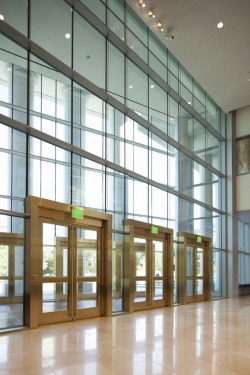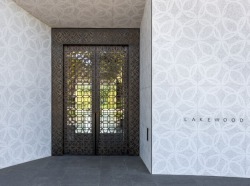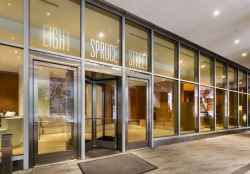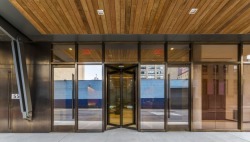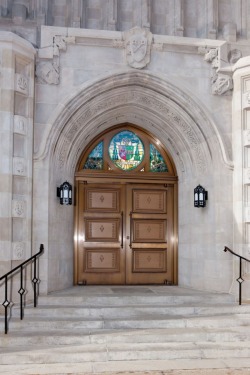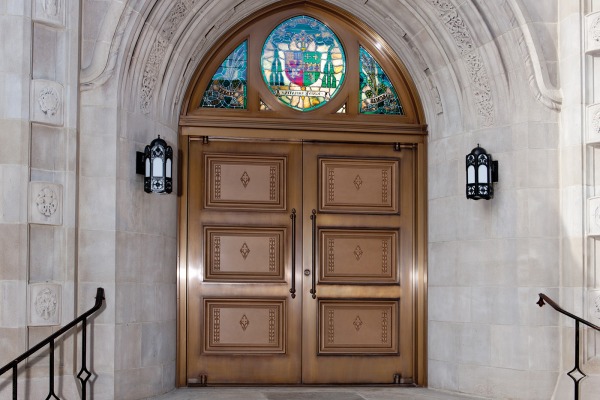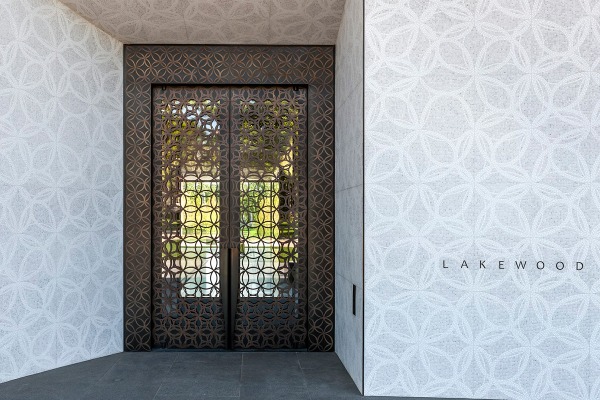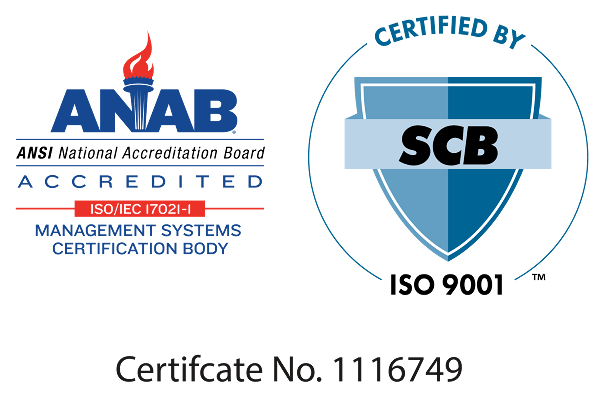Success in the Balance: Form and Function With Balanced Doors
Specifying doors is a complex task, given the various choices available to meet aesthetic and functional needs. When choosing a marquee entry, a specifier needs to consider several criteria.
First, the amount of traffic to the door must be anticipated. If the door’s location subjects it to constant use from foot traffic and exposure to the environment, the assembly needs to be a solid product resistant to deterioration and abuse. Second, the building’s wind and stack action pressure must be considered. The door needs to open easily and remain closed in all conditions. Third, the door must be able to be opened easily by all users, despite size and weight. Finally, if applicable, the door’s leaf projection to the exterior should be reviewed to prevent it from protruding onto the sidewalk area and possibly obstructing pedestrian traffic.
Available for more than 80 years, balanced doors can meet these challenges. Their design and solid construction means the fulcrum is inset at one-third the door’s width, which allows for large, heavy, and durable doors to be opened with relative ease. This design facilitates fluid opening and closing, even when strong external wind pressures and internal stack pressures exist, as the door works with—rather than against—these forces. This also ensures doors will remain closed and not flutter when confronted with uneven air pressure, ultimately reducing a facility’s energy costs.
Design options and possibilities
Balanced doors can complement any design, or act as the design centerpiece of the buildings they serve. Commonly offered in bronze, stainless steel, steel, aluminum, and wood, manufacturers can produce doors with virtually infinite combinations of materials, sizes, and designs. Sidelites and transoms can also be incorporated around the doors, but it is recommended architects and designers work with a curtain wall or storefront manufacturer to achieve a unified aesthetic between the door system and surrounding building area.
A durable and design-flexible balanced door system can be composed of formed-up bronze or stainless steel. Sheet stock is bent and formed to desired specifications, and is flexible enough to accommodate details such as flush-type glazing, wider door stiles and rails, and various finish options.
Balanced doors made from formed stainless steel or bronze are constructed with a minimum stile and top rail of 69.8 mm (2 ¾ in.), and a minimum bottom rail height of 152 mm (6 in.), though 254 mm (10 in.) is recommended to comply with the current 2010 Americans with Disabilities Act (ADA). The formed-up glass stops can accommodate various glass thicknesses from 6.35 to 25-mm (¼ to 1-in.) insulated glass, and have the capacity to accommodate bullet-resistant or blast-mitigation glass by making the door slightly thicker.
The formed-up balanced door features a tie-channel assembly, which extends all the way up and around the vision opening. It is made up of individual channel shapes welded at the corners to form a sub-assembly slid between the door skins. It is then spot-welded (i.e. resistance) into place for superior door rigidity and longevity. The formed-up door also features top and bottom channels, which are placed between the interior and exterior skins. Both the door skin and subframe materials are 2.2-mm (0.09-in.) thick bronze or stainless steel, which is among the heaviest used in door construction.
Extruded aluminum balanced doors are a budget option similar in structural appearance to formed stainless steel or bronze balanced doors. Aluminum extrusions are used in place of the formed metal. Aluminum material is available in an almost limitless number of polyvinylidene-fluoride (PVDF) or powder coating paint finishes, as well as traditional anodized finishes.
Stiles versus no stiles on a tempered glass door
For many years, architects have been designing entrances with less metal and more glass, which often leads to requests for tempered glass balanced doors. A tempered glass door may offer aesthetic benefits, but there are major issues that need to be considered when using them in a high-traffic exterior environment.
Balanced doors are available with tempered glass where the glass is the structure of the door, either with or without stiles. In either door type, full top and bottom rails are required to accommodate the balanced hardware, so patch block fittings are not an option.
Most balanced door manufacturers strongly recommend using stiles for added strength, door integrity, and energy efficiency. A narrow stile is in some cases unnoticeable, especially after the addition of push/pull or panic hardware.
Stiles provide edge protection and structural strength for a tempered glass door. When stiles are added, there is no exposed edge to the glass. This protects the vulnerable edge of the glass from possible damage and breakage, which could lead to personal injury and litigation. Glass deflection occurs as the glass gets taller. Glass is a flexible material; one way to mitigate this problem is to use vertical stiles on the glass edges.
On an aluminum tempered glass door, the narrow stiles are solid aluminum bar. On a stainless steel or bronze door, the stiles also use the solid aluminum bar and then are cladded to match the rest of the door using 2.2-mm (0.09-in.) cladding.
When architects specify tall doors over 2.7 m (9 ft), and are not using vertical stiles, 19-mm (¾-in.) glass is required. Adding narrow stiles, such as 25-mm (1-in.) aluminum stiles or 28.5-mm (1 1/8-in.) stainless steel or bronze stiles, allows the balanced door manufacturer to use 12.7-mm (½-in.) thick glass, in lieu of the 19-mm glass. This cuts down on the overall weight and cost of the door, as 19-mm glass is significantly more costly and heavier than 12.7-mm glass.
There is no effective way to place weatherstripping on a door that does not have vertical stiles. Stiles allow the door to be properly weatherstripped, which is necessary due to more stringent energy codes including American Society of Heating, Refrigerating, and Air-conditioning Engineers (ASHRAE) 90.1, Energy Standard for Buildings Except Low-rise Residential Buildings and the International Energy Conservation Code (IECC).
A 25-mm vertical stile allows polypropylene pile weatherstripping to be incorporated into the door. Without weatherstripping, there is poor energy efficiency. There are clear acrylic weatherstripping solutions that are taped on, but they tend to be ineffective and prone to discoloration and cracking. They also easily lose their adhesion and are often knocked off the door. With a stile, a tighter seal and a more energy-efficient solution can be created, in addition to eliminating wind noise that can occur when there are gaps around the door.
Frame options
A balanced door can be designed with a concealed hinge pivot shaft (within the vertical framing), making a full three-sided frame around the door, or more minimal framing can be used by having a header only with an exposed clad hinge pivot shaft. By exposing the hinge pivot shaft, it balances the metal used for the stile on the pull side as the eye is drawn to the vertical usage of metal.
The minimal frame approach is typically used in curtain wall applications and the shaft is often covered in the corresponding door material. The look is less bulky, but the balanced door still needs a header to contain the check and guide channel portion of the balanced hardware. Since there is no vertical framing and the shaft/cladding rotate, the header needs to be properly supported by the curtain wall material from above.
Engineering considerations
Engineering considerations to keep in mind to accommodate balanced doors include:
•top and bottom arm swing interference;
•hardware projection;
•finish hardware and;
•access to balanced door hardware.
A clear space needs to be provided for top and bottom arm swings and door travel to the interior. A balanced door projects to the interior—as the door opens, the heel edge swings inward and the arms rotate inward as well. This means there cannot be any interference with the ceiling for the balanced door to operate properly. For example, a soffit ceiling cannot be placed too close to the interior door opening adjacent to the doorframe’s back side. There needs to be enough room to allow the door to fully open.
The floor also needs to be kept free of interference for the balanced door path to the full open position. The floor cannot slope and, just as the ceiling above, the door needs room to allow the heel edge to swing in and the arms to rotate.
It is also important to ensure there are no columns or permanent obstruction blocking the heel edge. If the balanced doorframe is going to be partially recessed into an interior wall, it can be recessed about 38 mm (1 1/2 in.) and still provide enough space for the arms to rotate inward. A pocket in the surrounding wall material will be required if the frame is recessed more than 38 mm to allow the arms to fully rotate. If the frame is to be recessed into the exterior wall, the pull handle needs adequate clearance so it will not crash into the wall when the door is in the full open position.
The hardware and grillwork projection off the door’s exterior face must also be considered. Most balanced door manufacturers advise against using a horizontal pull handle because it cannot go all the way across the door’s face without interfering with the door jamb, preventing the door from fully opening. The door handles provide visual cues, with a vertical pull indicating pull action and horizontal pull indicating a push action. Users with physical limitations, such as crutches, find it difficult to open a door with horizontal pulls. The maximum projection of hardware and grillwork off the exterior face of the door at hinge side is 12.7 mm (½ in.).
The same finish hardware items used on a conventional swing door can be used on a balanced door. This can provide design and usage continuity throughout a space. Balanced doors can accommodate:
•push/pulls (except horizontal pulls);
•deadlocks;
•flushbolts; and
•manual panic exit devices and electronic locking hardware (i.e. surface maglocks, concealed shearlocks, electronic latch retraction panic exit devices, and electric release strikes).
It should be noted there are specific guidelines addressing the use of panic devices on a balanced door set by theInternational Building Code (IBC) and the National Fire Protection Association (NFPA).
BC, Section 1008.1.10.2, “Balanced doors,” states:
If balanced doors are used and panic hardware is required, the panic hardware shall be the push-pad type and the pad shall not extend more than one-half the width of the door measured from the latch side.
NFPA 101 Life Safety Code, Section 7.2.1.13, “Balanced door assemblies,” states:
If panic hardware is installed on balanced door leaves, the panic hardware shall be of the push-pad type, and the pad shall not extend more than approximately one-half the width of the door leaf, measured from the latch stile.
This requirement helps reduce the force needed to open the door leaf. The panic hardware actuating bar should be close to the latch side of the door and away from the roller and hinge side. This arrangement is more effective when using push-pad panic hardware that readily instructs the user where to push instead of a crossbar-style panic device.
If using stiles, a design that can accommodate the hardware requirements should be specified. For example, a concealed vertical rod-type panic device can only be used on a stile and rail type door with a wider stile, not on a narrow stile tempered glass door.
Finally, it is important to keep the balanced door hardware accessible. If the balanced door hardware needs to undergo maintenance or repair, the guide channels and doorjambs cannot be concealed.
Conclusion
The long-term functional and aesthetic benefits a balanced door system provides make it a suitable choice for commercial, institutional, and monumental facilities. When making the decision to incorporate a balanced door into the building design, it is important to choose an experienced manufacturer skilled in the design and maintenance of balanced door systems. The manufacturer should have a strong reputation for lasting doors and serviceability.
All balanced door systems should be periodically maintained to ensure a long service life, and an annual inspection is recommended. It is important to select a manufacturer that offers a comprehensive warranty for the entire door system, including the door, frame, and balanced hardware.
AIA Continuing Education
Receive 1 AIA CES HSW/SD credit hour through our new online course.

